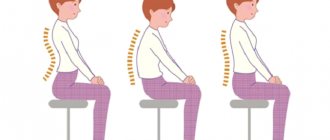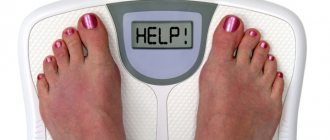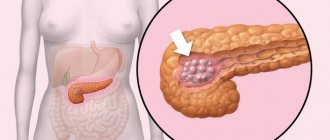Causes of obesity in children
- Gestational diabetes is diabetes acquired by the mother during pregnancy.
- Artificial or short (up to 6 months) breastfeeding.
- Consumption of high-calorie foods, high sugar, salt and fat content in the diet.
- Wrong eating habits.
- Insufficient physical activity, sedentary lifestyle.
Less common factors that increase the risk of the disease: hypothyroidism and other endocrine dysfunctions, genetic and hereditary disorders, lack of sleep and poor daily routine, and taking certain medications. Without correcting the causes, obesity persists into adolescence and adulthood. Most obese adults experienced weight problems during childhood.
Obesity levels
Diagnosis is made based on body mass index. This is a calculated value - weight divided by the square of height:
BMI = weight (kg)/height2 (m)
The resulting value is assessed taking into account age and gender.
Table 1. Obesity in boys based on BMI
| Age | Normal weight | Excess weight | Obesity |
| 1 | 17,2 | 19,4 | 19,9 |
| 2 | 16,5 | 18,4 | 19 |
| 3 | 16 | 17,8 | 18,4 |
| 4 | 15,8 | 17,5 | 18,1 |
| 5 | 15,5 | 17,3 | 18 |
| 6 | 15,4 | 17,4 | 18,1 |
| 7 | 15,5 | 17,7 | 18,9 |
| 8 | 16,4 | 19,3 | 22,6 |
| 9 | 17,1 | 19,4 | 21,6 |
| 10 | 17,1 | 21,4 | 25 |
| 11 | 17,8 | 21,2 | 23,1 |
| 12 | 18,4 | 22 | 24,8 |
| 13 | 19,1 | 21,7 | 24,5 |
| 14 | 19,8 | 22,6 | 25,7 |
| 15 | 20,2 | 23,1 | 25,9 |
| 16 | 21 | 23,7 | 26 |
| 17 | 21,6 | 2,7 | 25,8 |
Table 2. Obesity in girls based on BMI
| Age | Normal weight | Excess weight | Obesity |
| 1 | 16,6 | 18,6 | 19,3 |
| 2 | 16 | 18 | 18,7 |
| 3 | 15,6 | 17,6 | 18,3 |
| 4 | 15,4 | 17,5 | 18,2 |
| 5 | 15,3 | 17,5 | 18,3 |
| 6 | 15,3 | 17,7 | 18,8 |
| 7 | 15,5 | 18,5 | 19,7 |
| 8 | 15,9 | 18,8 | 22,3 |
| 9 | 16,4 | 19,8 | 23,4 |
| 10 | 16,9 | 20,7 | 23,4 |
| 11 | 17,7 | 20,8 | 22,9 |
| 12 | 18,4 | 21,5 | 23,4 |
| 13 | 18,9 | 22,1 | 24,4 |
| 14 | 19,4 | 23,2 | 26 |
| 15 | 20,2 | 23,2 | 27,6 |
| 16 | 20,3 | 22,8 | 24,2 |
| 17 | 20,5 | 23,4 | 25,7 |
The degree of obesity is determined by the deviation of BMI from the norm:
- 1st – 15-24%;
- 2nd – 25-49;
- 3rd – 50-99%;
- 4th – 100% and more Source: O.V. Vasyukova Obesity in children and adolescents: diagnostic criteria // Obesity and Metabolism, 2021, No. 16(1), pp. 70-73
Children in their first year of life are not diagnosed with obesity. Excess weight in a child during this period is called paratrophy. Paratrophy:
- 1st degree – weight is 10-15% higher than normal;
- 2nd degree – by 15-30%;
- 3rd – by 30% or more.
Table 3. Infants up to one year old. Average weight and height
| Age, months | Norm of weight gain for boys, grams | Norm of weight gain for girls, grams |
| 1 | 400-1 200 | 400-900 |
| 2 | 400-1 500 | 400-1 300 |
| 3 | 600-1300 | 500-1 200 |
| 4 | 400-1 300 | 500-1 100 |
| 5 | 400-1 200 | 300-1 000 |
| 6 | 400-1 000 | 300-1 000 |
| 7 | 200-1 000 | 200-800 |
| 8 | 200-800 | 200-800 |
| 9 | 200-800 | 100-600 |
| 10 | 100-600 | 100-500 |
| 11 | 100-500 | 100-500 |
| 12 | 100-500 | 100-500 |
Overweight in a child under 1 year of age: causes and consequences
Overweight in a child under 1 year of age: causes and consequences
If a baby gains weight well, this is not always an indicator of his healthy development. In what cases may excessive weight gain be a concern for parents and doctors?
overweight, baby food
Each child’s visit to the pediatrician includes weighing the child: this is how the doctor determines the child’s weight gain and reveals the dynamics of the baby’s development.
According to current standards for weight gain in children under 1 year of age, monthly weight should increase by an average of 600–800 g, based on birth weight. If a child gains 1 kg or more starting from 8–9 months, we are talking about excessive weight gain.
Signs and symptoms
In addition to excess weight and excess body volume, the disease causes:
- Infants have frequent constipation and bloating, excessive sweating, dermatitis and eczema. Possible difficulty breathing, frequent bronchitis and pneumonia.
- Preschoolers and primary schoolchildren have slow physical development and the appearance of fatty folds on the body. The child avoids active games with peers, and during physical activity he develops shortness of breath. Possible snoring during sleep, secondary flat feet and curvature of posture.
- In adolescents (10-19 years old) - disordered eating behavior (gluttony). Hypertension and depression are possible Source: https://www.ncbi.nlm.nih.gov/pubmed/18230896/ Sabin MA, Shield JPH. Childhood obesity // Front Horm Res. 2008;36:85-96. doi: 10.1159/000115356
Diagnosis of the disease
The main indicator when making a diagnosis is the calculation of BMI. Additional research allows us to determine the cause and choose effective treatment tactics. To do this, the doctor:
- conducts interviews and collects family history;
- measures the child's waist circumference and blood pressure;
- prescribes blood tests - biochemical, for the level of thyroid hormones and insulin;
- determines the amount of fat using bioimpedansometry;
- refers the child to an ultrasound of the thyroid gland and abdominal cavity, an ECG, examination by an endocrinologist, gastroenterologist, neurologist and geneticist.
Diagnostics
Diagnosis of obesity and determination of its degree includes studying anamnesis, determining the type (mixed, artificial or natural) feeding of the baby, current nutritional habits, and level of physical activity. The examination of the child includes measuring height and weight, waist and hip circumference, and calculating BMI. All indicators are compared with special tables (weight norms range from 25 – 50 – 75 centiles) and overweight or obesity is determined. When conducting a mass examination, a technique for measuring the thickness of the skin fold is used.
Related specialists participate in the diagnosis of obesity in order to determine its cause: pediatric endocrinologist, neurologist, gastroenterologist, and geneticist. Additionally, laboratory tests are prescribed: blood biochemistry (sugar, glucose tolerance test, cholesterol, triglycerides and lipoproteins, total protein and liver tests, uric acid), hormones (thyroid-stimulating hormones, insulin, prolactin, cortisol, estradiol). If necessary, ultrasound of the thyroid gland, electroencephalography, and MRI of the pituitary gland are performed.
What problems does obesity cause?
Possible complications:
- from the gastrointestinal tract - gastritis, duodenitis, colitis, chronic constipation and hemorrhoids;
- from the cardiovascular system - hypertension, coronary heart disease, atherosclerosis, heart attacks and strokes;
- from the musculoskeletal system - joint degeneration, curvature of the spine, protrusion and hernia of the spinal column, flat feet;
- dysfunction of the endocrine system - impaired insulin resistance and diabetes Source: M.V. Zagoruiko, T.P. Bardymova, L.V. Rychkova Obesity in children and adolescents // Siberian Medical Journal, No. 6, pp. 16-18
In addition, varicose veins of the lower extremities develop, and the risk of developing trophic ulcers, cancer of the colon, mammary glands and uterus increases.
What are the dangers of being overweight in a child?
The more extra pounds a child carries, the more difficult it is for the body.
The load on the cardiovascular and respiratory systems increases, and the musculoskeletal system suffers. Regular overeating contributes to the development of digestive problems, pancreatitis and cholecystitis. Grade 1 obesity often seems insignificant because the child does not look fat. However, even this can lead to:
- curvature of the spine;
- high blood pressure;
- headaches;
- gastritis.
2nd degree causes more significant violations:
- increased sweating;
- hormonal imbalances;
- blackheads and acne (in adolescence).
With the development of stage 3 obesity, children develop:
- joint diseases;
- disorders of puberty and reproductive function;
- femoral and inguinal hernia;
- increased risk of diabetes mellitus and arterial hypertension.
Stage 4 is an extremely dangerous condition.
Even a child can develop such serious diseases as diabetes, atherosclerosis, hemorrhoids, angina pectoris, liver failure, etc. The risk of breathing disorders during sleep (night apnea) increases. In advanced cases, the ability to move independently is lost because the spine and joints cannot support the weight of one’s own body. We must not forget about the psychological complexes that are caused by excess weight in a child. Children can be bullied at school, and the inability to fully play with peers only makes the situation worse. In adolescence, this can result in complexes.
Treatment: clinical recommendations
The main type of treatment for obesity is correction of nutrition and drinking regime. Includes changing the regimen - the child is fed 5-6 times a day, the doctor calculates the daily water consumption individually. With each dose - towards the evening - the calorie content of the serving is reduced. The child should eat the main part of the diet in the first half of the day, the last meal should be 2-3 hours before bedtime. It is important to control the pace of eating - it should be slow.
In the structure of the diet, it is necessary to limit the consumption of carbohydrates at the expense of quickly digestible ones. Fast food, industrial semi-finished products, confectionery and sweet soda are excluded from the menu. The amount of fat is reduced due to refractory ones of animal origin. The child should receive sufficient amounts of protein, complex carbohydrates and vegetable fats, vitamins and minerals. Unbalanced diets, a sharp reduction in salt and other “adult” diets for children are dangerous and unacceptable. An individual menu is developed by the attending nutritionist.
In addition, regular feasible physical activity is required - at least 1 hour a day. It is extremely important that family members also normalize their eating behavior and lifestyle.
In severe cases - if physiological disorders are identified - drug therapy may be prescribed. It is carried out strictly under the supervision of a doctor. Self-medication is strictly prohibited.
Treatment
Treatment of obesity in children has the following goals:
- child weight loss;
- treatment of concomitant pathology;
- maintaining reduced weight;
- prevention of weight gain.
First of all, the doctor must establish the cause of obesity, after which individual treatment is selected for the child, which includes normalizing nutrition and prescribing a therapeutic diet, physical therapy, if necessary, drug therapy and (if indicated) surgical treatment.
Therapeutic diet
A diet for a child is developed by a pediatric nutritionist. The purpose of therapeutic nutrition is to inhibit the formation of fatty deposits and stimulate the destruction of accumulated deposits. It is important to consider that following a therapeutic diet is contraindicated for children three years old and younger. Therapeutic nutrition for obesity should be varied and balanced and include the following principles:
- Fractional meals
The child should eat frequently, up to 6–7 times a day, but in small portions, with breaks between each meal of no more than 3 hours.
- Food processing
For young children, food is boiled, steamed, stewed or baked (without crust). Older children are allowed to eat fried foods occasionally.
- Limiting salt
Eliminate from the diet all pickles, marinades, smoked meats, fast food and various snacks (chips, nuts, crackers). Also limit the amount of salt to 5 grams per day. Consumption of salty foods causes thirst, and taking large amounts of liquid provokes its retention in the body (edema).
- Fluid intake
Categorically avoid drinking sweet carbonated drinks, packaged juices and nectars, replacing them with unsweetened teas, herbal infusions and freshly squeezed juices without sugar.
- Distribution of calorie content of food
Basic nutritious meals (meat, fish, poultry) should be consumed in the first half of the day, when the child’s physical activity is high. The last meal should be no later than 3 hours before bedtime (maximum at 19.00).
- Increased plant fiber
The child should eat vegetables, berries, fruits and a variety of greens without restrictions and in any form (raw, stewed, boiled). Sweet fruits are not recommended: bananas, pears, persimmons, figs, dates, grapes.
List of permitted products:
- lean varieties of meat, fish and poultry;
- low-fat fermented milk products, cottage cheese;
- boiled eggs;
- cereals: millet, buckwheat, barley, pearl barley, oats.
- wholemeal bread.
List of prohibited products:
- baked goods, culinary products, cookies;
- pasta;
- White bread;
- semi-finished products and sausages;
- jam, raisins, honey, sweets;
- semolina;
- chocolate and cocoa;
- spices and spices (increase appetite).
Physical activity
The doctor will prescribe exercise therapy classes for the child, which should be carried out daily for at least 60 minutes. Also, obese children need to take walks regardless of the weather, participate in active games in the fresh air, swim, and ride a bike. It is optimal to enroll your child in a sports section. Parents should introduce the concept of “violation of the regime” into everyday life when the child could not resist and ate what was forbidden. As punishment, physical exercise is required (10 squats, 5 push-ups, and so on). An effective method for combating excess weight is massage, which stimulates metabolism, improves blood and lymph flow, and normalizes muscle tone.
Drug and surgical treatment
Taking medications and dietary supplements for weight loss is not recommended for children under 15 years of age. For stage 3 disease, it is possible to prescribe orlistat and metformin under the supervision of a physician. Physiotherapy is an alternative to drug treatment: heliotherapy, hydrotherapy, mud therapy, etc. Surgical correction is used in extreme cases (the child’s weight exceeds the norm by more than 100%).
Prevention in children and adolescents
- Early initiation of breastfeeding - within 1 hour after birth.
- Exclusive breastfeeding for at least the first 6 months.
- Balanced complementary foods.
- In school and adolescence - control the total consumption of fats and sugar. You should increase your intake of protein, whole grains, legumes, vegetables and fruits.
- Regular physical activity of at least 1 hour per day.
- Maintaining healthy eating habits in the family. Source: A.A. Kamalova Modern approaches to the prevention of obesity in children // Russian Bulletin of Perinatology and Pediatrics, 2021, No. 6, pp. 43-47.
To avoid irreparable harm to the health of a child with signs of obesity, consult a specialist in a timely manner.
Sources:
- O.V. Vasyukova. Obesity in children and adolescents: criteria for diagnosis // Obesity and Metabolism, 2021, No. 16(1), pp. 70-73.
- https://www.ncbi.nlm.nih.gov/pubmed/18230896 Sabin MA, Shield JPH. Childhood obesity // Front Horm Res. 2008;36:85-96. doi: 10.1159/000115356.
- M.V. Zagoruiko, T.P. Bardymova, L.V. Rychkova. Obesity in children and adolescents // Siberian Medical Journal, No. 6, pp. 16-18.
- A.A. Kamalova. Modern approaches to the prevention of obesity in children // Russian Bulletin of Perinatology and Pediatrics, 2021, No. 6, pp. 43-47.
The information in this article is provided for reference purposes and does not replace advice from a qualified professional. Don't self-medicate! At the first signs of illness, you should consult a doctor.
Childhood obesity - an epidemic of the 21st century
Currently, obesity is one of the most common diseases: every 4th inhabitant of our planet is overweight or suffers from obesity. In all countries, there is a progressive increase in the number of patients, both among adults and children. In this regard, WHO has recognized obesity as an epidemic of the 21st century.
In Western European countries, up to 20% of men and 25% of women are overweight or obese. The leader is the United States, where increased body weight is recorded in 60% of the population, and obesity in 27%. According to scientists, by the end of the first decade of the 21st century, 40% of men and 50% of women on the planet will already suffer from obesity. On the one hand, obesity is a consequence of a modern lifestyle with consumption of fatty foods and low physical activity, on the other hand, obesity often occurs due to genetic defects of the obese gene.
In Japan, representatives of the Society for the Study of Obesity admitted that the problem of obesity in the country is becoming a tsunami, threatening the health of the nation.
Obesity in children and adolescents is on the rise worldwide.
It is important to overcome the stereotype of public consciousness, according to which overweight people are lovers of good food, since they often consume no more food than people with normal weight, and the cause of obesity lies in the presence of complex metabolic disorders in the body, leading to accumulation and deposition excess fat.
Childhood obesity is an increasingly serious problem worldwide. In just 20 years, the number of obese children aged 6 to 11 has doubled, and the number of overweight teenagers has tripled.
National associations around the world annually publish reports that every year there are more and more overweight teenagers and children.
Such children are at increased risk of developing the following diseases: type 2 diabetes, metabolic syndrome, hypertension and, as a result, early strokes and heart attacks.
Excess weight in a child can lead to the early development of diseases that are not typical for childhood, such as hypertension, type 2 diabetes mellitus, coronary heart disease, cirrhosis of the liver, etc. These diseases, in turn, worsen the quality of life and reduce a person’s life expectancy. The following complications of obesity in children and adolescents are distinguished:
- Complications from the cardiovascular system: high blood pressure, angina pectoris, chronic heart failure, atherosclerosis. All these diseases are typical for older people, but they also occur in obese children.
- The digestive system is characterized by chronic cholecystitis (inflammation of the gallbladder), pancreatitis (inflammation of the pancreas), constipation and hemorrhoids are possible. The deposition of fats in the liver leads to the development of fatty hepatosis (or hepatic steatosis) - failure of liver function as a result of the replacement of normal tissue with adipose tissue. In rare cases, fatty liver disease leads to the development of liver cirrhosis.
- Disorders of the musculoskeletal system include deformation of the bone skeleton, joint pain, destruction of articular cartilage, and flat feet. Obese children have genu valgus (knees touching and feet apart, with legs forming an "X")
- Lack of insulin (a pancreatic hormone that promotes the absorption of glucose) leads to the development of type 2 diabetes. The main signs of diabetes are: weakness, drowsiness, frequent urination, increased appetite and thirst. See All about Type 2 Diabetes and its Treatment.
- Overweight children are much more likely to experience sleep disorders: snoring, apnea (episodes of lack of breathing) during sleep.
- Obesity in adolescence often causes social isolation (lack of friends among peers), depression, which ultimately can lead to drug addiction, alcoholism, or the development of eating disorders (bulimia, anorexia).
- Women who have been obese since childhood or adolescence have a higher risk of developing infertility.
The term obesity was used 17 times in the text, your child probably hears this addressed to him no less often. Help him. Our department staff can help your child cope with the problem. Do not leave your most loved one without help. Obesity can and should be fought.










